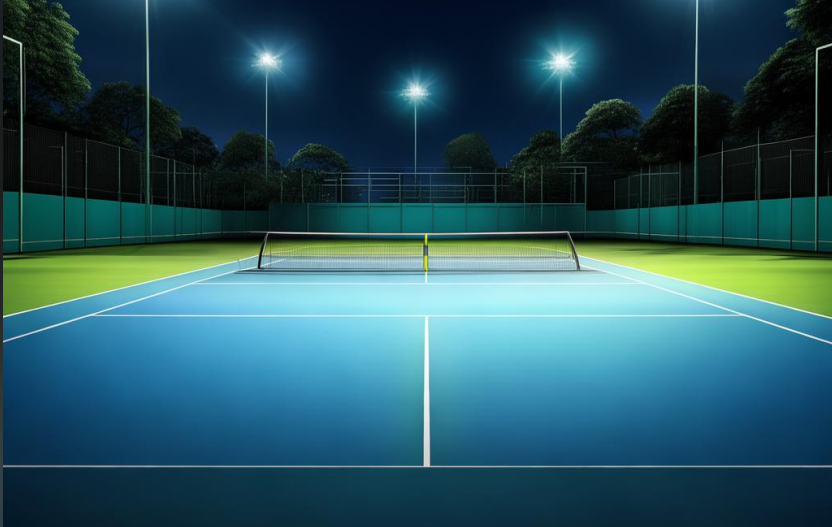The Tennis Court Lighting Design
Tennis Court Lighting Design

Tennis Court Lighting Design, the key elements are competition, broadcasting, and safety. As the development and popularity of sports and competitions continue to rise, the number of participants and spectators is increasing, leading to heightened lighting requirements. The lighting infrastructure must ensure that athletes and officials can clearly see all activities and scenes on the court, enabling optimal performance. Additionally, spectators should enjoy the game in a comfortable and pleasant environment. Furthermore, the lighting design must deliver high-quality broadcast images for the television audience. For venues with high spectator density, it is crucial to facilitate safe entry and exit for large crowds and ensure rapid evacuation in emergencies.
1. Venue Lighting Implementation Method
The center court is an indoor tennis facility constructed primarily of steel. The lighting installation method chosen is the horse track approach. After consultations with various professionals in electrical, structural, and architectural disciplines, the horse track's location was finalized. This positioning satisfies the requirements for horizontal and vertical illumination, glare control, and other essential parameters. The projection angle of all fixtures on the horse track is restricted to 65 degrees, avoiding the athletes' rear during play to prevent glare from impacting the opposing team.
2. Camera Position Selection for Vertical lighting
For vertical illumination calculations, the camera positions must be established. Following discussions with sports technology experts, the configuration is illustrated in Figure 3. There are four camera locations in the audience area: the main camera, auxiliary camera, and full-court camera; additionally, six field cameras are positioned, including sideline, baseline, and local cameras behind the baseline. The requirements for mobile photography are also validated based on the four-sided vertical illumination algorithm.
3. Glare Observation Points for Lighting Design
In the design of sports lighting, it is necessary to calculate the GR value at typical observation points (athlete positions), using the highest value as the maximum for field GR calculations.
4. Lights Projection Positioning
In broadcast-quality sports lighting, to ensure that any location within the venue receives lighting from multiple directions (fulfilling vertical illumination requirements and reducing stroboscopic effects), the lamp projection directions are depicted in the accompanying figure.
Considerations for tennis Court Lighting Design
1. When selecting design standards for specialized lighting systems intended for large-scale events, it is essential to thoroughly evaluate national standards, international practices, event specifications, and other factors to fulfill operational needs before, during, and after games, as well as to satisfy sports requirements and broadcasting criteria during competitions.
2. The positioning of lighting fixtures is closely related to architectural and structural disciplines, and the selection of installation locations (such as walkways or lamp poles) must be guided by lighting requirements. Different levels of lighting demands will necessitate varying installation positions, and collaborative feedback from multiple stakeholders can enhance the design.
3. High-level venue lighting design typically requires the identification of camera placements, which are dictated by event specifications. Consequently, camera positions should be established based on established conventions and competition needs, rather than arbitrary decisions.
4. In lighting design, the illuminance value should reflect the maintenance level, as factors such as light source degradation, lamp surface dirt, and internal dust can diminish output, with variations influenced by regional climatic conditions.
5. Beyond lighting, indoor arenas may also accommodate additional professional services, such as audio systems, necessitating a comprehensive assessment to determine load requirements.
6. When utilizing lamp poles for lighting, selecting fixtures with low wind resistance can help minimize pole costs. If the lamp features a split design, positioning the electrical box beneath the lamp pole facilitates easier maintenance and further reduces overall expenses.
7. If budget permits, it is advisable for venue lighting and spectator seating illumination to utilize equipment with matching color temperatures to avoid visual discomfort during broadcasts.
8. In instances where multiple rows of fixtures are mounted on a light pole, the rows should be angled inward by approximately 15 degrees rather than arranged vertically to prevent lower fixtures from obstructing those above.
9. Any alterations to lamp positions will impact lighting outcomes. While some changes may be acceptable, others could significantly affect results, necessitating re-evaluation.
10. The design of lighting for tennis courts must account for the Technical Area (TA) and Player Area (PA). Generally, the lighting requirements for the TA are one level lower than those for the PA, yet they remain critical. In broadcast-level venues, lamp positioning benchmarks must be established according to the TA to ensure compliance with standard requirements.
_thumb.jpg)